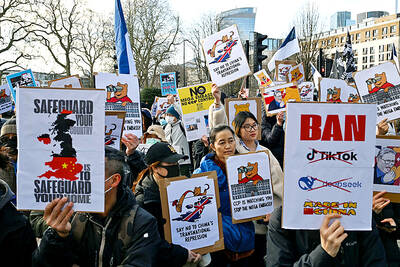Handmade in jail, the Chinese characters on Hong Kong’s old road signs have a distinct style that a group of enthusiasts has painstakingly documented and turned into a new digital font called Prison Gothic.
Their leader, Gary Yau, said he became interested in them when he was a boy, even learning to write some characters by copying them from road signs.
As signs made with computer-generated text began to replace the old ones, Yau began a personal quest in 2016 to record the handmade characters, imperfections and all.

Photo: AFP
“I want to preserve this local, visual culture,” 24-year-old Yau said. “The search and collection have been like a race against the authorities, because we do not know when they will retire an old sign.”
Before digital design and production were introduced, the characters and symbols on Hong Kong’s road signs were hand-drawn, carved out and assembled by inmates in the territory’s prisons.
Without the precision of computers and machine-cutting, these signs were not uniform, with varying characters and line thickness.

Photo: AFP
Over the past six years, Yau and his team of six — the Road Research Society — have scoured the streets of Hong Kong to find 500 of these older signs, produced by prisoners from the 1970s to the 1990s.
The 600 Chinese characters they collected from these signs became the base from which they developed a digital typeface of about 8,000 commonly used characters.
This month, the Road Research Society — which Yau founded in his freshman year at university — launched a crowdfunding initiative to secure HK$700,000 (US$89,177) for the last leg of the project.
The medium version of the font is to be released in November this year.
The irony that road signs for travelers are made by people in jail is not lost on Yau, who said he was impressed by their skill.
David Tsang, a broadcast engineer in the US, was one of the first to leave a supportive comment on Yau’s crowdfunding page.
“It feels like carrying an old soul ... reminding me of the old Hong Kong,” Tsang said. “I want to preserve some Hong Kong culture and personality as a Hong Konger overseas.”
The link between a font and identity is not unique to Prison Gothic.
At least half a dozen Hong Kong-inspired fonts have been invented or revamped since 2016, a period when two major pro-democracy movements sparked interest in localism — promoting the concept of the territory’s unique identity.
Hong Kong, like Taiwan, uses traditional Chinese characters, as opposed to the simplified ones used in China.
Some of the Hong Kong designs borrow from calligraphy styles that were once widely seen on shop signs, and on wooden or stone tablets on traditional village gates.
At least two — the Kick Ass Type and the Rebirth Font — were inspired by the 2014 Umbrella movement and the huge pro-democracy protests in 2019 respectively.
Prison Gothic itself has taken on a different resonance in the last few years, as Beijing has imposed a political crackdown on Hong Kong that has seen thousands arrested for taking part in the protests three years ago.
“Responding to the social movements and changes is a big incentive for the fonts’ development,” said Brian Kwok (郭斯恒), associate professor at Hong Kong Polytechnic University’s School of Design.
“In the past, symbols of Hong Kong local culture might be egg tarts, milk tea and the Lion Rock,” Kwok said. “Now fonts have become a way for young people to explore their Hong Kong identity.”

BOMBARDMENT: Moscow sent more than 440 drones and 32 missiles, Volodymyr Zelenskiy said, in ‘one of the most terrifying strikes’ on the capital in recent months A nighttime Russian missile and drone bombardment of Ukraine killed at least 15 people and injured 116 while they slept in their homes, local officials said yesterday, with the main barrage centering on the capital, Kyiv. Kyiv City Military Administration head Tymur Tkachenko said 14 people were killed and 99 were injured as explosions echoed across the city for hours during the night. The bombardment demolished a nine-story residential building, destroying dozens of apartments. Emergency workers were at the scene to rescue people from under the rubble. Russia flung more than 440 drones and 32 missiles at Ukraine, Ukrainian President Volodymyr Zelenskiy

‘SHORTSIGHTED’: Using aid as leverage is punitive, would not be regarded well among Pacific Island nations and would further open the door for China, an academic said New Zealand has suspended millions of dollars in budget funding to the Cook Islands, it said yesterday, as the relationship between the two constitutionally linked countries continues to deteriorate amid the island group’s deepening ties with China. A spokesperson for New Zealand Minister of Foreign Affairs Winston Peters said in a statement that New Zealand early this month decided to suspend payment of NZ$18.2 million (US$11 million) in core sector support funding for this year and next year as it “relies on a high trust bilateral relationship.” New Zealand and Australia have become increasingly cautious about China’s growing presence in the Pacific

Indonesia’s Mount Lewotobi Laki-Laki yesterday erupted again with giant ash and smoke plumes after forcing evacuations of villages and flight cancelations, including to and from the resort island of Bali. Several eruptions sent ash up to 5km into the sky on Tuesday evening to yesterday afternoon. An eruption on Tuesday afternoon sent thick, gray clouds 10km into the sky that expanded into a mushroom-shaped ash cloud visible as much as 150km kilometers away. The eruption alert was raised on Tuesday to the highest level and the danger zone where people are recommended to leave was expanded to 8km from the crater. Officers also

ESPIONAGE: The British government’s decision on the proposed embassy hinges on the security of underground data cables, a former diplomat has said A US intervention over China’s proposed new embassy in London has thrown a potential resolution “up in the air,” campaigners have said, amid concerns over the site’s proximity to a sensitive hub of critical communication cables. The furor over a new “super-embassy” on the edge of London’s financial district was reignited last week when the White House said it was “deeply concerned” over potential Chinese access to “the sensitive communications of one of our closest allies.” The Dutch parliament has also raised concerns about Beijing’s ideal location of Royal Mint Court, on the edge of the City of London, which has so